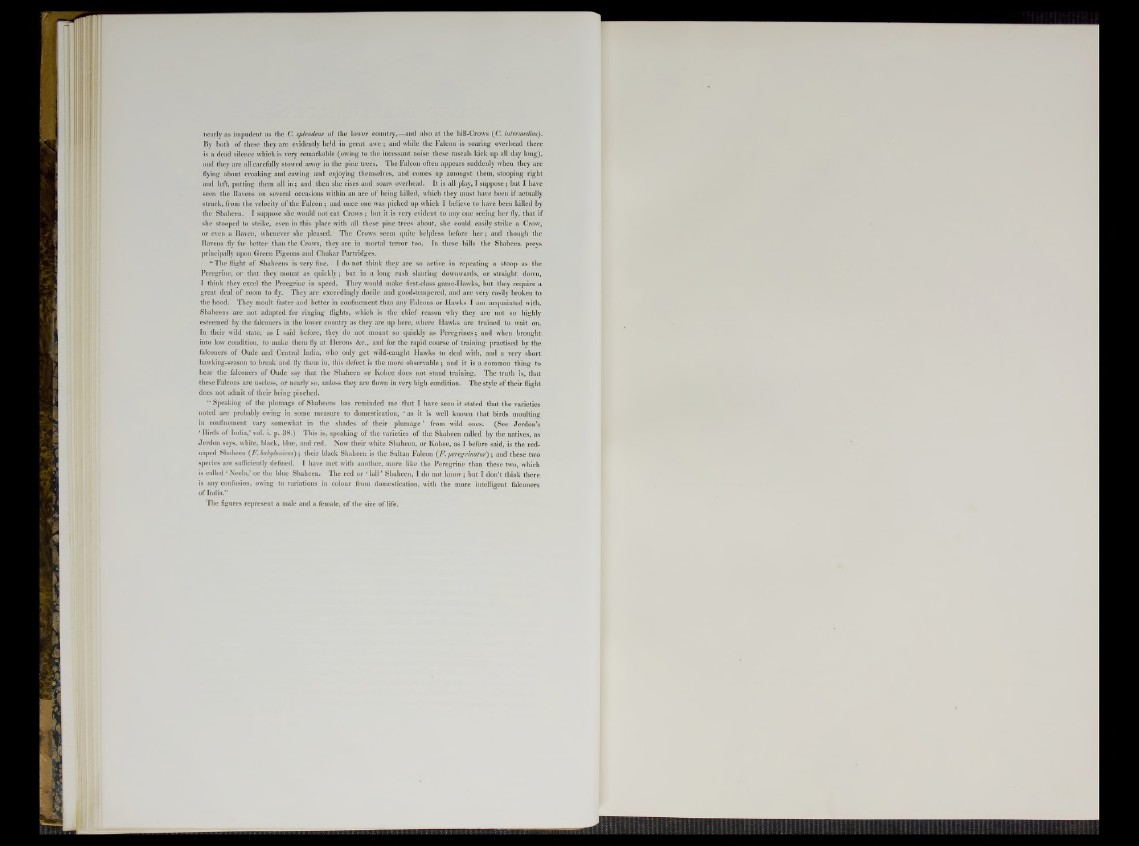
nearly as impudent as the C. splendens of the lower country,—and also at the hill-Crows (C. i?itermedius).
By both of these they are evidently held in great awe; and while the Falcon is soaring overhead there
is a dead silence which is very remarkable (owing to the incessant noise these rascals kick up all day long),
and they are all carefully stowed away in the pine trees. The Falcon often appears suddenly when they are
flying about croaking and cawing and enjoying themselves, and comes up amongst them, stooping right
and left, putting them all in ; and then she rises and soars overhead. It is all play, I suppose; but I have
seen the Ravens on several occasions within an ace of being killed, which they must have been if actually
struck, from the velocity of the Falcon; and once one was picked up which I believe to have been killed by
the Shaheen. I suppose she would not eat Crows ; but it is very evident to any one seeing her fly, that if
she stooped to strike, even in this place with all these pine trees about, she could easily strike a Crow,
or even a Raven, whenever she pleased. The Crows seem quite helpless before her; and though the
Ravens fly far better than the Crows, they are in mortal terror too. In these hills the Shaheen preys
principally upon Green Pigeons and Chukar Partridges.
“ The flight of Shaheens is very fine. I do not think they are so active in repeating a stoop as the
Peregrine, or that they mount as quickly; but in a long rush slanting downwards, or straight down,
I think they excel the Peregrine in speed. They would make first-class game-Hawks, but they require a
great deal of room to fly. They are exceedingly docile and good-tempered, and are very easily broken to
the hood. They moult faster and better in confinement than any Falcons or Hawks I am acquainted with.
Shaheens are not adapted for ringing flights, which is the chief reason why they are not so highly
esteemed by the falconers in the lower country as they are up here, where Hawks are trained to wait on.
In their wild state, as I said before, they do not mount so quickly as Peregrines; and when brought
into low condition, to make them fly at Herons See., and for the rapid course of training practised by the
falconers of Oude and Central India, who only get wild-caught Hawks to deal with, and a very short
hawking-season to break and fly them in, this defect is the more observable; and it is a common thing to
hear the falconers of Oude say that the Shaheen or Kohee does not stand training. The truth is, that
these Falcons are useless, or nearly so, unless they are flown in very high condition. The style of their flight
does not admit of their being pinched.
“ Speaking of the plumage of Shaheens has reminded me that I have seen it stated that the varieties
noted are probably owing in some measure to domestication, ‘ as it is well known that birds moulting
in confinement vary somewhat in the shades of their plumage ’ from wild ones. (See Jerdon’s
‘ Birds of India,’ vol. i. p. 38.) This is, speaking of the varieties of the Shaheen called by the natives, as
Jerdon says, white, black, blue, and red. Now their white Shaheen, or Kohee, as I before said, is the red-
naped Shaheen (F. babylonicus) ; their black Shaheen is the Sultan Falcon (F. peregrinator) ; and these two
species are sufficiently defined. I have met with another, more like the Peregrine than these two, which
is called ‘ Neela,’ or the blue Shaheen. The red or ‘ lall ’ Shaheen, I do not know; but I don’t think there
is any confusion, owing to variations in colour from domestication, with the more intelligent falconers
of India.”
The figures represent a male and a female, of the size of life.
TTTTFT